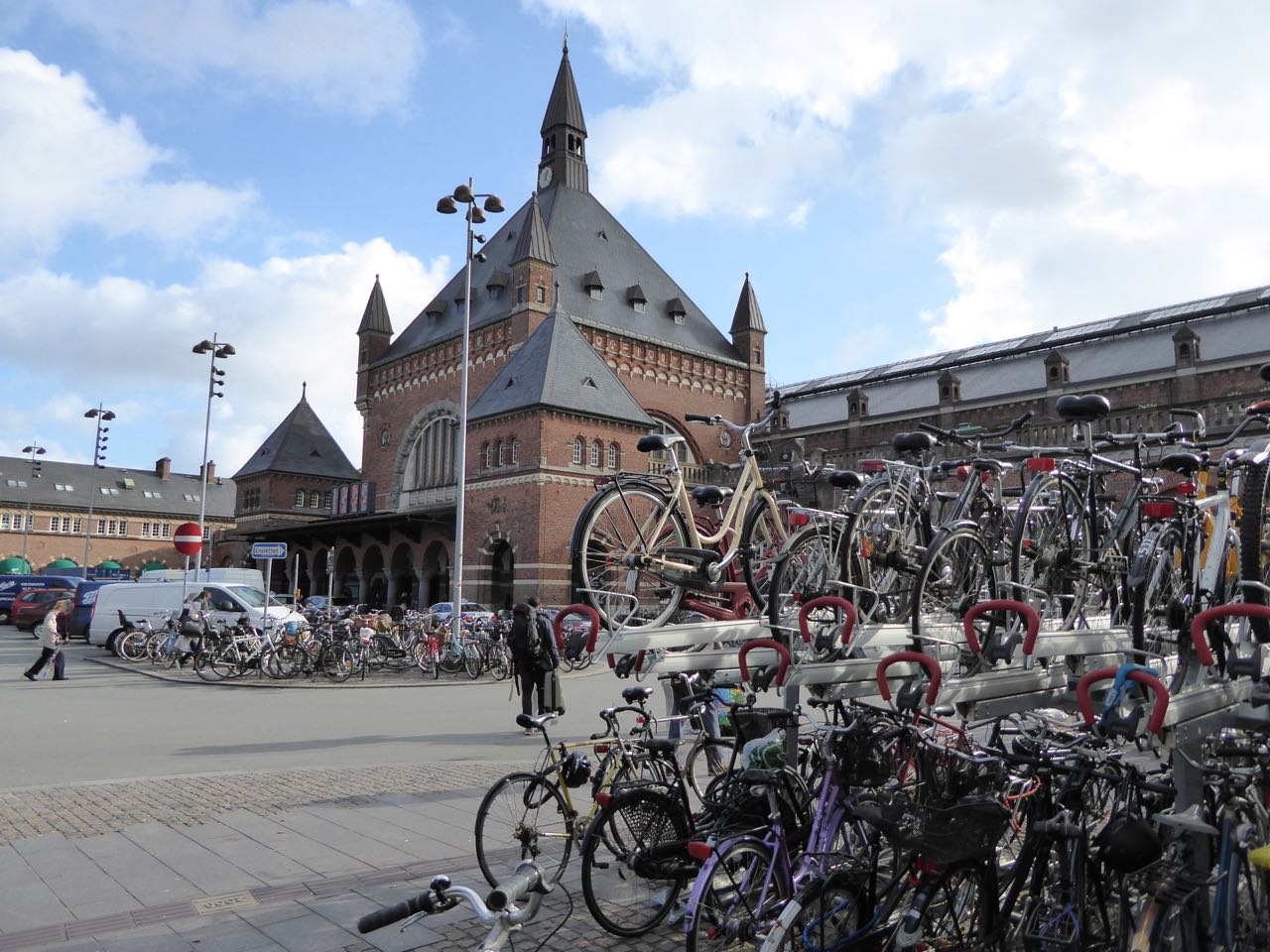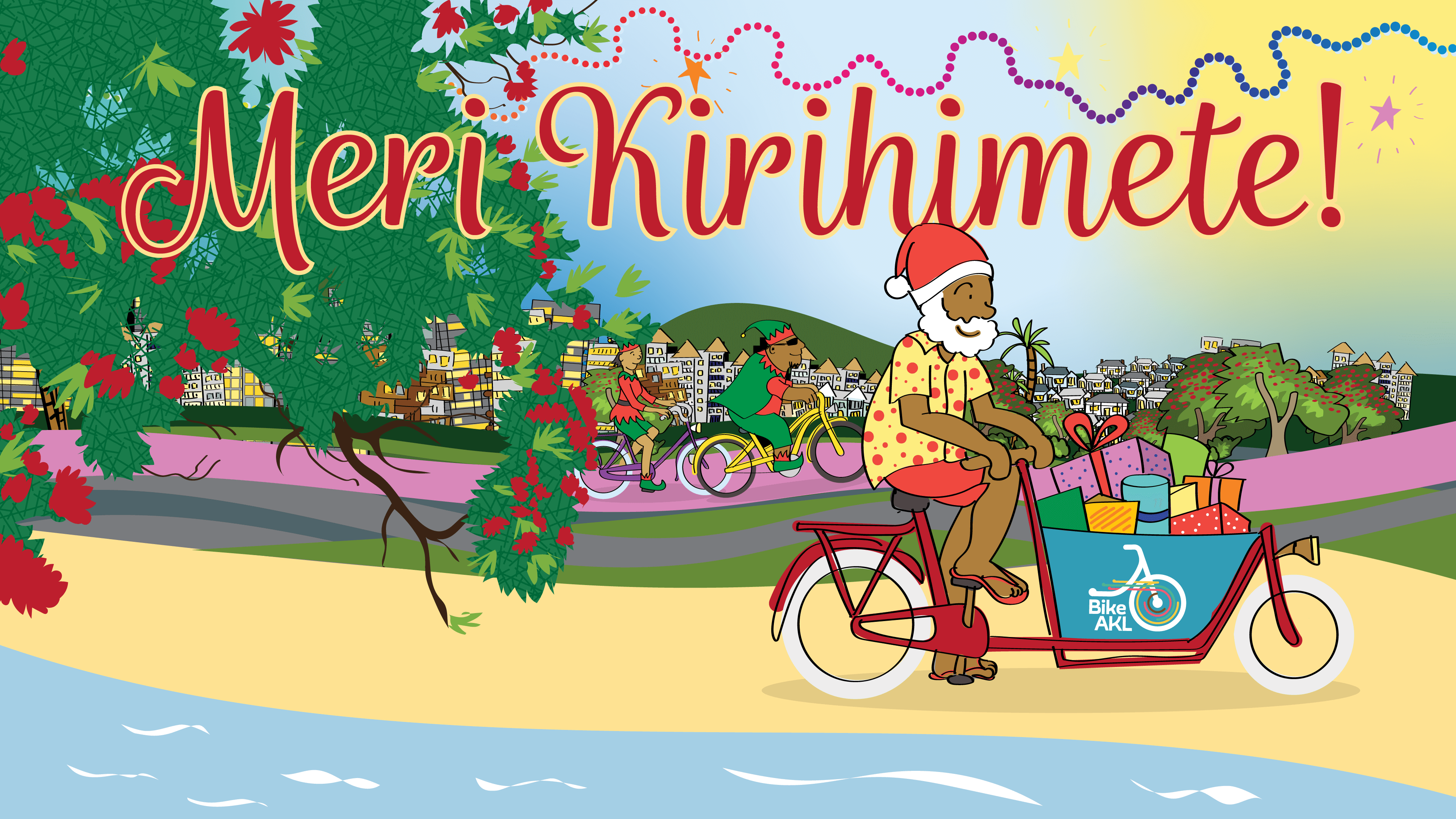I’ve been fortunate enough to have spent two months in Europe, from the cycling utopias of the Netherlands and Denmark, travelling south through a number of countries to Italy. As one of Cycle Action’s committee members with a background in engineering, I was particularly keen to understand what changes these countries either had made or were making to further encourage cycling. Perhaps there could be lessons for us here in NZ?
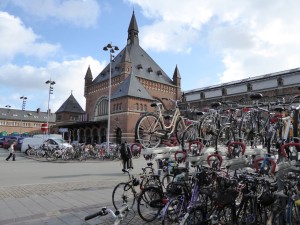
It would be fair to say that to be a cyclist in Auckland you need to be smart and brave, because for a cyclist our roading environment is perceived as hostile. In many places in Europe you only need to be smart, because for both adults and kids hopping on a bike is the most natural and practical way to get around. Even primary school children ride unaccompanied between home and school. Try suggesting that to a parent in Auckland!
In New Zealand it’s our politicians, urban planners and traffic engineers who need to be brave, so those who wish to hop on a bike don’t need to be.
That’s our challenge – a transfer of bravery.
Here’s my take on what needs to change in NZ, and a few ideas from those clever Europeans to help make it happen. Most examples are taken from the Netherlands and Denmark, but surprisingly the Germans, Austrians, Hungarians and Italians are also making substantial progress in making their cities more cycle-friendly, so I have some examples from them too. All photos are my own unless attributed, and permission is granted to anyone who wishes to use my photos to illustrate potential cycling improvements as I have done.
Interestingly, the Europeans are doing one thing wrong with their cycling infrastructure. I’ll touch on this later – in Lesson 19!
Lesson 1 – Changing the motoring mindset
The 1950s was the start of the glorious age of the motor car. Walking, cycling and rail were removed from the early designs of the Harbour Bridge, tram tracks were ripped up in the suburbs, and public transport started a decline. Who wants a tram, bus or train when you have the autonomy and freedom afforded you by your very own motor car, and can park it where you want for next to nothing? Who wants an apartment when you can have your own quarter acre section and drive at speed to where you want to go?

And so it persists for over half a century. Our politicians, planners and engineers grew up and were educated in this era, as were most of the voting public. It’s all we’ve ever known as Aucklanders, it’s what we expect, and increasingly realise we can’t have as Auckland grows and congestion grinds us to gridlock.
But the Dutch and Danes had a reality check in the 1970s. So many children were being killed by cars they cried, “Enough! We need to make our roading environment safe for people on foot and on bicycles”. Combined with the oil shocks of the seventies, these were the catalysts that led to the 30-40% cycling mode share you see in these countries today.
We need our own catalyst in NZ to initiate rapid change. Our politicians and planners begrudgingly acknowledge the benefits of cycling, and that building more and bigger roads can’t solve our congestion problems.
But there are no politicians in power with the courage to lead the charge and sway the motoring mindset so we can invest heavily in cycling infrastructure.
The Cycling Safety Panel recommendations arising from the Coronial review into our recent cycling fatalities may perhaps be our catalyst. Here’s hoping there will be some heavyweight support and funding to implement its recommendations, and perhaps some of the ideas the Europeans are using which I’ve noted below.
Lesson 2 – Developing the infrastructure
This is fundamental to removing the fear factor that prevents so many people from even considering hopping on a bike. At present we expect cyclists to ride on the road and share the road space with motorists. If cyclists are lucky, they might get a painted white line separating them from traffic.
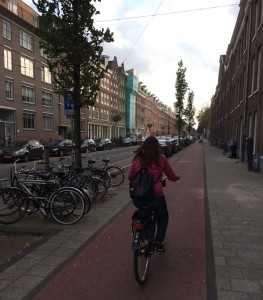
The Dutch and Danes would be incredulous with this approach. At the very least they would design cycle paths which are physically separated from motorists, either by a raised kerb, vegetation, or parked cars (a “Copenhagen lane”). Only with the direst lack of space do they deviate from this.
Another interesting observation from Europe is that cycle connectors join centres together, but within a centre the cycling infrastructure takes the form of a grid, just as the footpaths do. This acknowledges that people want to move safely pretty much at random within a town centre, both on foot and by bike.
Translating this to Auckland Central, it means that all our north/south and east/west streets need to have some form of cycling provision, as should Ponsonby, Newmarket, Takapuna etc, with efficient connectors joining them. It’s not sufficient to just define a few bike routes through them and leave the rest up to chance.
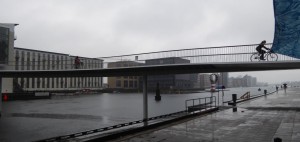
Talking of connectors, I had the pleasure to view (but sadly not cycle) the Snake Bridge in Copenhagen. When the Danes want to span a waterway to link some inner suburbs with the city for pedestrians and cyclists, they go ahead and build an elegant bridge. And they don’t charge users a toll to use it.
Lesson 3 – Synergy between bikes and trains
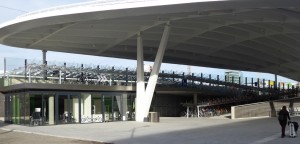
Trains and bikes work superbly together.
Trains dramatically increase the range of bikes, while bikes dramatically increase the patronage catchment area for trains. In Europe most trains have provision for bikes, and every station has bike parking, including the smallest rural towns.
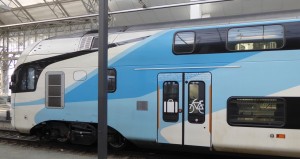
The huge cycle parking lots at Dutch and Danish train stations are par for the course, but how about this? In alpine Salzburg’s station there’s a two-level bike parking area with lockers, and a bike service centre tucked into the corner of it. Salzburg’s population? A mere 150,000.
Interestingly the Europeans are rapidly expanding their rail network – in quality, speed and frequency. Rail is a proven technology that’s getting better and better. In Berlin they have their own version of Alice, but she’s drilling a new rail subway tunnel, not a motorway connection.
As we debate if and when the CRL should proceed I sense the Europeans laughing at us. Why an earth haven’t you started already?
Lesson 4 – Synergy between bikes and high density living
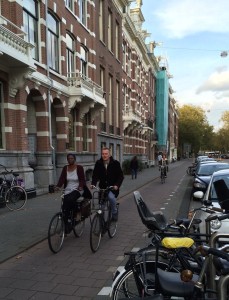
The tyranny of our current motorised mindset is that it has resulted in Auckland’s vast urban sprawl and a relatively low population density. This makes it more difficult to promote both public transport and cycling. The Europeans learnt long ago that apartment living in human-scale buildings of three to five stories is the solution, both within the town centres and in the vicinity of transport hubs.
When people live in relatively close proximity to their employment, education, PT, service and leisure activities a bike is all you need to get around. The car stays in the garage for longer trips, not every day commuting.
That’s why increasing the density of our town centres and inner city suburbs is so important, and in general our planners are onto it with the first cut of the Unitary plan. Sadly the mindset is pushing back and the initiatives are being diluted by gentrified inner city suburbanites prioritising their own interests rather than embracing change for the benefit of the community. It’s where we need some serious civic leadership.
Lesson 5 – Changing the attitude of motorists
Ask an overseas driver what they think of NZ motorists, and typically the response will be aggressive, fast and impatient, with road rage regularly making the news. The motoring mindset is that roads are made for high speed motor vehicle travel, and any form of impediment, whether a slower vehicle, cyclist or pedestrian shouldn’t be on the road. Cyclists draw the most antipathy due to their slow speeds and inability to legally use footpaths, forcing them onto the roadway.
This is a hostile environment for cyclists, and attitudes need to change. The Europeans tackle this in three ways:
- Separation – keep pedestrians, bikes and motor vehicles apart wherever possible
-
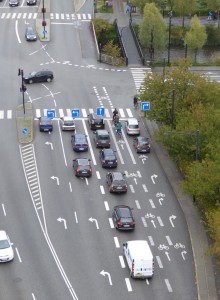
Aarhus (Denmark) intersection Legal liability – where cyclists and motorists come into conflict, put the onus of preventing a collision on the larger vehicle. This works incredibly well. In Amsterdam my wife, a novice cyclist, had no trouble hopping on a hire bike and cycling around the city. She wouldn’t dare do this in Auckland. Dutch and Danish motorists ease away from intersections like this one in Aarhus, checking carefully in all directions for pedestrians and cyclists, giving way as necessary. It’s an incredibly conducive environment for cycling, knowing that motorists are looking out for you rather than trying to bully you off the road
- Numbers – more than the safety in numbers effect, it’s reasonable to expect that every Dutch (or Danish) motorist also rides a bike, or has close family or friends who ride bikes. When it’s so close to home, you’re more careful. This one will take time for Aucklanders as the cycling mode share slowly increases.
Law changes and education campaigns are sorely needed in NZ to change motorist attitudes to vulnerable road users. While a mandated 1.5m separation while passing is good, why stop there? Let’s embrace the European example for greater benefit.
Lesson 6 – Ready availability of cheap commuter bikes
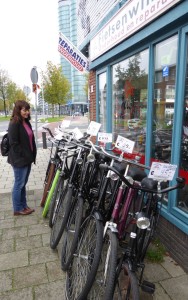
Our cycling culture in NZ has traditionally been focused on light weight sports bikes, mountain bikes, and kids bikes, not utility bikes or commuters.
In European cities it’s rare to see carbon fibre or drop bars, but very common to see cheap commuter bikes with an upright riding position, built-in lights, panniers, three-speed hubs, mudguards and protective chain cases.
There’s a strong second hand market as well, with prices around the 100 to 150 euro mark (say a ballpark of $200).
It’s good to see many of our bike shops now entering the commuter market, and inevitably there will be more models as demand increases.
Lesson 7 – Greater promotion of electric bikes
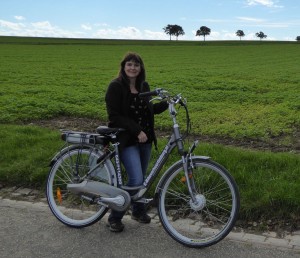
While Amsterdam and Copenhagen are fairly flat, the same can’t be said for Maastricht in the Netherland’s south-west, where it’s considerably hillier. Here there is a greater proportion of electric bikes to take the sweat out of the hills, and to ride for longer trips.
My wife and I did a 50km loop through the hilly Maastricht countryside on electric bikes, and as a keen mountain biker I have to admit it opened my eyes. These things can fly.
Their range is also remarkably good. After 50km we still had two-thirds charge in the battery, and if we looked like we were running low, plenty of cafes have recharge points. What a clever idea to attract coffee and snack-loving cyclists!
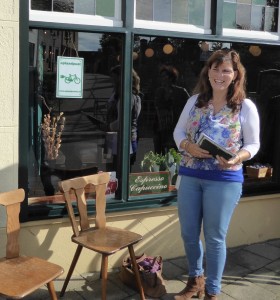
For the cynics who think Auckland’s too hilly for cycling, think again.
Electric bikes are benefitting from improvements in design and battery technology, and they’re getting cheaper. Their time has come.
Bute Bikes in Browns Bay has been in the market for a while, but an increasing number of retailers are now stocking them.
And for the roadies who look down their noses at electric bikes, you can think again too.
Not only can you get a good draft behind them (if you can catch them), the safety in numbers effect really starts to make a difference when there are more and more bikes on the road.
Lesson 8 – Ordinary clothing and lack of helmets
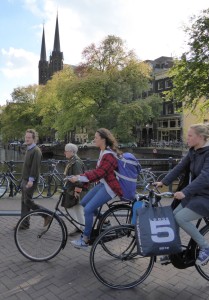
One of the most striking things about cycling in Amsterdam and Copenhagen is the lack of special clothing.
People just dress in their ordinary clothes, and hop on a bike as casually as they’d pull on some walking shoes.
No day-glow colours, no lycra, no cleated riding shoes, no helmets (apart from the kids). Perhaps just a scarf, gloves and beanie if it’s cold.
In NZ our cycling environment is so hostile that helmets are mandated, and high-viz clothing recommended.
The Europeans have a much better approach – make the roading environment less hostile through good infrastructure and good road-user behaviour, and people don’t have to scream “dangerous activity” whenever they get on a bike.
Lesson 9 – Hire bikes
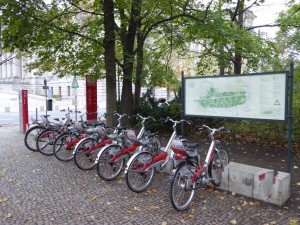
This is an interesting one.
In Amsterdam just about everyone has a bike, so hire bikes are less common and you have to seek them out.
In cities where the cycle mode share is lower but there’s adequate cycle infrastructure, public hire schemes are both prevalent and popular – take Berlin for example.
Needless to say, the ability to register and hop on a bike without worrying about helmets or special clothing is a big plus. NextBike is popular in Austria, and my wife and I had no problems picking up a pair of bikes in Melk and pedalling the banks of the Danube to Krems.
Is Auckland ready for hire bikes?
We’ve tried and failed with a metropolitan scheme because our poor cycling infrastructure and helmet requirements attracted so few it was uneconomic without subsidies, and hire bikes remain a small niche activity for some bike shops.
We must do better.
Lesson 10 – Slow vehicle speeds
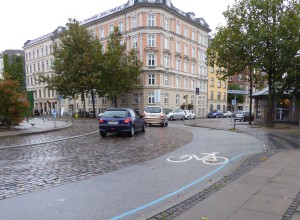
The speed limit in many of the built-up areas and town centres in Europe is generally 30kph.
It’s not just a posted speed limit that serves to reduce vehicle speeds – the entire roading environment “feels” like a 30kph zone.
The most effective measures are what come naturally to old European towns – narrow streets, limited visibility, and cobblestones.
Our traffic engineers know this already – narrow lanes, ambiguity in the roading environment and paving that generates audio-tactile feedback to the motorist all serve to slow vehicles down (while maintaining nice smooth lanes for cyclists).
We just need more of it.
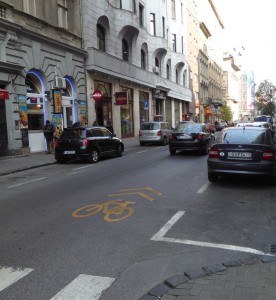
A good start would much a greater prevalence of 30kph zones in built-up areas, an increasing use of sharrows to identify the presence and preferred roadway location for cyclists on quiet streets, and with selective increases to 50kph only where cyclists are effectively separated from motorised traffic.
Lesson 11 – One way streets (for cars)
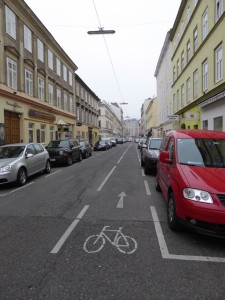
The Europeans are pretty smart with this.
When you have two streets running in parallel, why have two-way traffic down both of them?
When you turn them into a pair of one-way streets you can reclaim road space for cycle paths while retaining some on-street parking, so motor vehicle traffic isn’t significantly disadvantaged.
But here’s the clincher – the streets remain two-way for cyclists, and of course they’re also safer for pedestrians to cross.
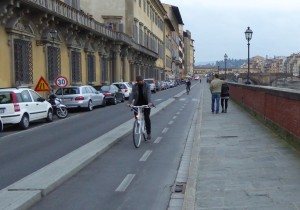
This street along the Arno in Florence used to be two-way.
Now it’s one-way for cars, and two-way for bikes.
We can use similar strategies in Auckland.
Lesson 12 – Bollards
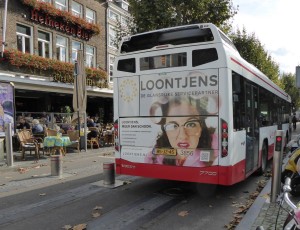
There are times when it’s inappropriate for motor vehicles to enter certain areas.
Permanent restrictions can be enforced by fixed bollards which stop cars, but of course allow cyclists and pedestrians through (the concept of permeability).
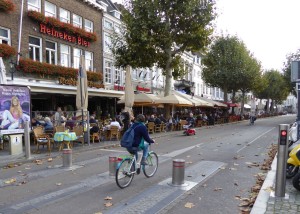
But what about when emergency and special vehicles need to get through?
Rather than the rather clunky padlocking of removable bollards, how about ones that just sink into the ground when activated by selected vehicles?
You see rising bollards like this all over the place in Europe.
Lesson 13 – Ubiquitous cycle parking
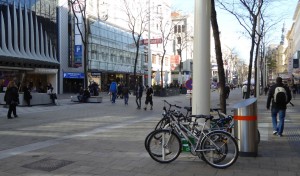
Cycle parking at transport hubs has already been covered, and is an obvious no-brainer due to the synergy between cycling and PT.
But if we want good cycling amenity everywhere, we need to provide cycle parking at every opportunity, not in isolated pockets where a map is needed to find them.
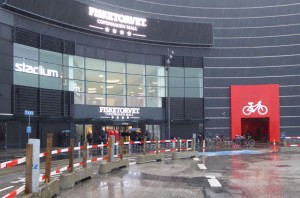
Need to park at the shopping centre? Make it obvious where to find the cycle parking.
We’re chronically bad at providing cycle parking at shopping centres, with the expectation being that everyone drives.
As Auckland intensifies and car parking becomes more frustrating (just look at the mall chaos pre-Christmas) we need to get serious about providing more cycle parking where people want to shop.
It’s in the retailer’s best interests after all.
Lesson 14 – Managing car parking
Europeans have cars too, and in high density living areas there’s certainly no room on the street for all of them. So bury them.
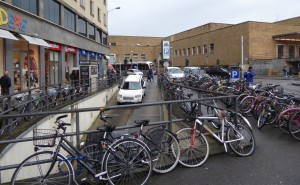
Underground car parks are common, and free up the land above for civic, residential or commercial activities. They’re certainly not cheap, but they are an effective solution.
This frees up the roadway for its proper purpose – safely and efficiently moving people and goods about. Yes in selected areas you can park on the street, but it’ll cost you – say 3 to 10 euros ($5-16) per hour in Munich. A resident wanting on-street parking? Sure – in places – that’ll be around 30 euros ($50) a month.
Again this is where our motoring mindset needs to change. There is an expectation in NZ that roadside parking should be cheap or free. But it’s certainly not free to provide, nor maintain, and the primary purpose of a roadway is movement, not private property storage.
This is another area where our politicians and transport planners need to show leadership. As the last cab off the rank, cycling provision is almost always at odds with on-street parking. Auckland Transport knows the right thing to do, but is frustrated by political and stakeholder backlash from those still carrying last century’s motoring mindset.
Lesson 15 – Limit cars entering the central city
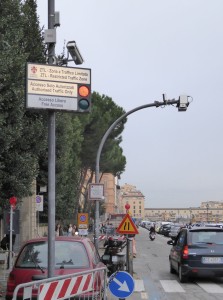
European towns and cities have grown up around the idea of large central public spaces where people come first.
Combined with narrow streets, high volumes of cars are simply incompatible, so their entry is restricted.
Florence is a good example. Here the ZTL (limited traffic zone) only permits local residents, service vehicles and public transport. Cross this boundary (even as a tourist in a hire car) and you’re pinged 80 euros ($130).
This may not be appropriate for Auckland yet, but as we’re investigating various tolling mechanisms to raise transport funding, it’s clear the technology is well-proved.
Lesson 16 – Priority and legitimacy across side roads
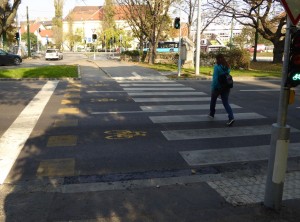
One of the frustrating things about designing cycling infrastructure in NZ is that there’s no cycle equivalent of a pedestrian crossing.
Cyclists have priority across intersecting side roads if on-road, but what’s the best way to handle a Copenhagen lane or shared path?
What about integrating cycle paths with pedestrian crossings?
And do motorists know to give way?
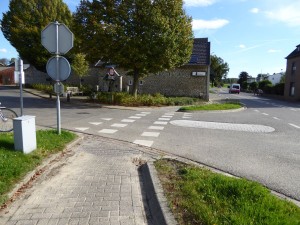
The Europeans have clear signs, marking and laws, whereas our environment is ambiguous.
Our traffic engineers sometimes revert to routing a path back on-road just to gain priority across side roads – hardy conducive to novice cyclists who shy away from close proximity to motorised traffic.
And let’s make it easy for cyclists to have priority where needed, and legally cross with pedestrians, ideally with specifically marked facilities.
Lesson 17 – Special signal phasing at intersection crossings
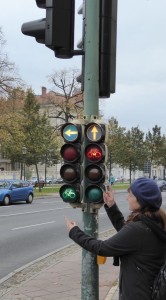
With so many bikes about, pretty much every intersection has cycle aspects built into their traffic signals. Why is this so hard in Auckland?
Consider the downtown ferry terminal on Quay St. Bikes pour in and out, but there are no shared paths to the west, and no cycle aspect to cross Quay St heading south.
Or the Esmonde Rd shared path, where cyclists have no priority across side roads and no aspects on the signals even when the way is clear.
Lesson 18 – Maintenance of bike paths and all-weather cycling
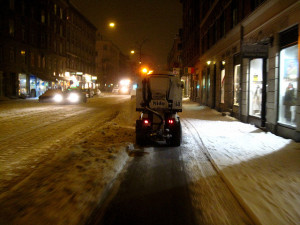
By separating cyclists and motorists, cycle paths are less prone to encountering detritus dropped from or caused by motor vehicles, but they’re still regularly swept.
Indeed when it snows in Copenhagen the cycle lanes get swept first!
In Europe the presence of a bit of rain (or snow) is little disincentive to cycling – it just means a change in the clothing that’s chosen to be worn.
There’s a perception in Auckland that it’s too cold or wet to be able to cycle. The reality is that we’re blessed with one of the best climates in the world – not too hot, not too cold, and with the relatively infrequent rain and showers easily managed.
Lesson 19 – Sharing the cycle paths with scooters (not!)
Here’s the one lesson from Europe which we don’t want to import to NZ. In Europe scooters and mopeds can use the cycle paths, but in reality they’re a hazard. Supposedly limited to 30kph, the scooter riders are both fast and aggressive, and can be quite intimidating to slower cyclists and pedestrians crossing their path.
Let’s keep scooters on the road with motorised traffic where they can easily keep up, and reserve the cycle paths for bicycles with pedals, either manual or with electrical assist.
Proposal – The study tour
I’m rather hoping an AT or NZTA manager or a politician might be reading this and saying, “Well, it sounds good. If like the leading European cities we could get a cycling mode share of over 30% in Auckland it would solve our congestion problems in an instant, generate huge benefits for our community, and save pouring billions of dollars into roading projects of dubious economic benefit. But I’m not sure…”.
So how about a study tour to see for yourself?
- Go to Copenhagen and Amsterdam to see what the end result could look like, not forgetting other Danish and Dutch cities like Aarhus and Groningen as well
- Go to Berlin, Vienna and Budapest to see how highly motorised urban environments are being proactively transformed into cycle-friendly environments in an attempt to catch up to their northern neighbours
- And go to Prague, not just because it’s an incredibly beautiful city, but their abysmal cycling infrastructure and aggressive motorists will remind you of Auckland. Ask them what their plans and challenges are. Agree to repeat the visit in five years time to see who’s made the most progress!
Then come back to Auckland with your cycling ideas, and do more than pay lip service to transforming Auckland into the world’s most liveable city. Read the Cycling Safety Panel recommendations, be brave, be the agent of change, and work with Cycle Action to make cycling happen here.
You’ll know when you’ve got it right when you can say, “I’d be happy for my primary school child/grandchild to cycle unaccompanied between home and school ”.
That’s how good it can be if the mindset changes and sufficient investment is made in cycling infrastructure.
I’ve seen it for myself.

